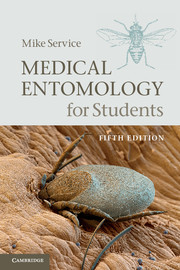Book contents
- Frontmatter
- Contents
- Preface to the first edition
- Preface to the second edition
- Preface to the third edition
- Preface to the fourth edition
- Preface to the fifth edition
- Acknowledgements
- 1 Introduction to mosquitoes (Culicidae)
- 2 Anopheline mosquitoes (Anophelinae)
- 3 Culicine mosquitoes (Culicinae)
- 4 Black flies (Simuliidae)
- 5 Phlebotomine sand flies (Phlebotominae)
- 6 Biting midges (Ceratopogonidae)
- 7 Horse flies (Tabanidae)
- 8 Tsetse flies (Glossinidae)
- 9 House flies and stable flies (Muscidae) and latrine flies (Fanniidae)
- 10 Flies and myiasis
- 11 Fleas (Siphonaptera)
- 12 Sucking lice (Anoplura)
- 13 Bedbugs (Cimicidae)
- 14 Triatomine bugs (Triatominae)
- 15 Cockroaches (Blattaria)
- 16 Soft ticks (Argasidae)
- 17 Hard ticks (Ixodidae)
- 18 Scabies mites (Sarcoptidae)
- 19 Scrub typhus mites (Trombiculidae)
- 20 Miscellaneous mites
- Appendix Names of some chemicals and microbials used in vector control (with common trade names in parentheses)
- Glossary of common terms relevant to medical entomology
- Select bibliography
- Index
- Plate section
- References
5 - Phlebotomine sand flies (Phlebotominae)
Published online by Cambridge University Press: 05 June 2012
- Frontmatter
- Contents
- Preface to the first edition
- Preface to the second edition
- Preface to the third edition
- Preface to the fourth edition
- Preface to the fifth edition
- Acknowledgements
- 1 Introduction to mosquitoes (Culicidae)
- 2 Anopheline mosquitoes (Anophelinae)
- 3 Culicine mosquitoes (Culicinae)
- 4 Black flies (Simuliidae)
- 5 Phlebotomine sand flies (Phlebotominae)
- 6 Biting midges (Ceratopogonidae)
- 7 Horse flies (Tabanidae)
- 8 Tsetse flies (Glossinidae)
- 9 House flies and stable flies (Muscidae) and latrine flies (Fanniidae)
- 10 Flies and myiasis
- 11 Fleas (Siphonaptera)
- 12 Sucking lice (Anoplura)
- 13 Bedbugs (Cimicidae)
- 14 Triatomine bugs (Triatominae)
- 15 Cockroaches (Blattaria)
- 16 Soft ticks (Argasidae)
- 17 Hard ticks (Ixodidae)
- 18 Scabies mites (Sarcoptidae)
- 19 Scrub typhus mites (Trombiculidae)
- 20 Miscellaneous mites
- Appendix Names of some chemicals and microbials used in vector control (with common trade names in parentheses)
- Glossary of common terms relevant to medical entomology
- Select bibliography
- Index
- Plate section
- References
Summary
Within the subfamily Phlebotominae of the family Psychodidae it is estimated that there are approaching 1000 species and subspecies of sand flies, in five or six genera (depending on whether Psychodopygus is considered a subgenus or genus). Three genera – Phlebotomus, Lutzomyia and Sergentomyia – suck blood from vertebrates, the former two being the more important because they contain disease vectors.
The genus Phlebotomus occurs only in the Old World, from southern parts of northern temperate areas, mainly the Mediterranean region, to central Asia, and in tropical areas, but there are not many species in sub-Saharan Africa or Southeast Asia and none in the Pacific area. Most Phlebotomus species inhabit semiarid and savanna areas in preference to forests. Lutzomyia species are found only in the New World, and, by contrast, occur mainly in forested areas of Central and South America.
Sergentomyia species are also confined to the Old World, being found mainly in the Indian subregion, sub-Saharan Africa and Asia. Although a few species bite people they are not vectors.
The medically most important species include Phlebotomus papatasi, P. sergenti, P. argentipes, P. ariasi, P. perniciosus and species in the Lutzomyia longipalpis and L. flaviscutellata species complexes. In both the Old and New Worlds sand flies are vectors of leishmaniasis and viruses responsible for sand fly fever, and in theAndes the bacterium Bartonella bacilliformis, causing bartonellosis (Carrión’s disease).
- Type
- Chapter
- Information
- Medical Entomology for Students , pp. 98 - 107Publisher: Cambridge University PressPrint publication year: 2012



